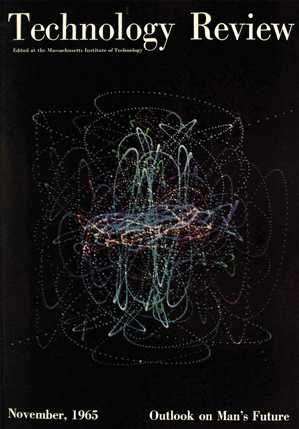Excerpted from “Food and Health: Contrasts Deepen,” by Nevin S. Scrimshaw, head of MIT’s Department of Nutrition and Food Science, in the November 1965 issue of Technology Review.

“The present world population could be fed easily by the agricultural production of conventional foods if only there were time for crop yields in the less developed countries to catch up with population needs and if purchasing power kept pace. Since neither is occurring today, it is prudent to look to less conventional solutions to part of the food problem. There is no fixed nutritional requirement for the relatively costly sources of protein—milk, meat, and eggs. Legumes and the oilseed meals are acceptable alternatives. After the seeds of soy, cotton, sesame, peanut, and sunflower plants are commercially pressed, the resultant meal contains approximately 50 per cent protein, and the oil can be sold to pay much of the cost.
One-third of a properly processed oilseed meal mixed with two-thirds of cereal grain gives a mixture whose quality and concentration of protein is adequate for all human needs.
Algal proteins have attracted much attention, and the idea of a mechanical cow to extract edible protein from the juice of grass and leaves has been seriously advanced. The problem thus far has been poor palatability and relative high cost, but these are merely a challenge to food technologists.
Still more significant to those aware of the resources of modern science and technology is the steady progress toward new foods wholly synthetic in origin. The nutritional needs of the human body can be reduced to chemically known substances, and all of these can be synthesized or extracted from natural products. The needed vitamins and minerals are already so available and cheap as to constitute no problem. Of the eight essential amino acids needed instead of protein, the two for which there is commercial demand already are available by the ton, and there is no doubt that the others could be if demand were established.
At present it is prohibitively expensive to feed humans on diets of synthetic nutrients, and no suitable formulations are available, but highly palatable, attractive synthetic foods are within reach of modern technology.”
Keep Reading
Most Popular
Large language models can do jaw-dropping things. But nobody knows exactly why.
And that's a problem. Figuring it out is one of the biggest scientific puzzles of our time and a crucial step towards controlling more powerful future models.
How scientists traced a mysterious covid case back to six toilets
When wastewater surveillance turns into a hunt for a single infected individual, the ethics get tricky.
The problem with plug-in hybrids? Their drivers.
Plug-in hybrids are often sold as a transition to EVs, but new data from Europe shows we’re still underestimating the emissions they produce.
Stay connected
Get the latest updates from
MIT Technology Review
Discover special offers, top stories, upcoming events, and more.